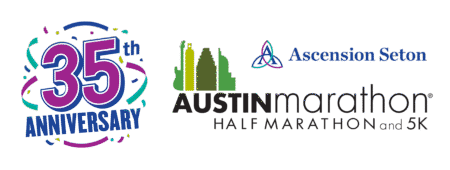Tag Archive for: 2020 Ascension Seton Austin Marathon
Austin Marathon Joins AbbottWMM Wanda Age Group World Rankings
in Blog post2021 Austin Marathon participants can earn Age Group World Rankings points
The 30th annual Ascension Seton Austin Marathon has been selected as one of the qualifying marathons for the Abbott World Marathon Majors Wanda Age Group World Rankings. The qualifying period of the 3rd edition of the rankings begins Oct. 12, 2020. The Austin Marathon will take place in Austin, Texas, on Feb. 14, 2021.
Compete against runners from around the world
The spread of the AbbottWMM Wanda Age Group Qualifying Events creates a truly global series throughout the year. This gives runners across the world the chance to be part of a new era of age group marathon running. The 3rd edition features a 14-month cycle for participants to earn up to two qualifying times and a place at the AbbottWMM Wanda Age Group World Championships in 2022.
“The interest and excitement around the series continues to build, and as the second edition is in full swing, we are busy working to expand into new locations for the third year, said Tim Hadzima, Executive Director of Abbott World Marathon Majors said. “With the increase in world ranking races, we hope to give even more runners the chance to find a qualifying event within reach and realize their dream of trying to make it to the world championships. Thank you to all our partners and race organizers who help us develop the opportunities for age group runners across the globe.”

Credit – Scott Flathouse
World ranking’s details and information
- Qualifying period runs from Oct. 12, 2020 – Dec. 31, 2021
- The World Championships will take place in the spring/summer of 2022
- The venue and details will be announced by mid-2021
- Participants in an AbbottWMM Wanda Age Group World Ranking qualifying race will earn points according to their:
- age
- time
- gender
- age groups (men and women): 40-44, 45-49, 50-54, 55-59, 60-64, 65-69, 70-74, 75-79, 80+
- Due to the extended length of the 3rd edition of the world rankings to take us through to the end of 2021, some marathons will have their 2020 and their 2021 events included in the same qualifying period
- Where a race is featured twice in the one ranking period, runners can score points in both editions and use them as their two point-scoring races
- Visit the AbbottWMM website for more information on the scoring system and world rankings visit
Completing the 30th annual Austin Marathon will be a huge accomplishment! Make it an even bigger feat when you compete against runners from around the world. Participate in the AbbottWMM Wanda Age Group World Rankings and let the training begin!
Increase Your Mileage with this Helpful Advice
in Blog postYou’ve set a bigger goal, now it’s time to increase your mileage
It’s been said that running is addictive. First-timers will feel it. Veterans know to expect it. Naturally, we want to go further and further, push the boundaries. Testing ourselves is one way to build our self-esteem and learn about mental fortitude. Setting a bigger goal can be overwhelming when you look at the goal by itself. But we’re here to help every step of the way! Follow our guide below for the best way to increase your mileage. It’s the best way to grow as a runner, reduce the chance of injury, and work towards your big goal!
REST – (1-2 times per week)
 If your training plan calls for a rest day, TAKE THE REST DAY. This allows your body the chance to recover from the previous run or workout. If you get the itch to do something, make it active recovery. Foam roll throughout the day. Set aside time for deep stretching. Take an online yoga class. Those three options will speed up the recovery process and get you ready to run your best the next day.
If your training plan calls for a rest day, TAKE THE REST DAY. This allows your body the chance to recover from the previous run or workout. If you get the itch to do something, make it active recovery. Foam roll throughout the day. Set aside time for deep stretching. Take an online yoga class. Those three options will speed up the recovery process and get you ready to run your best the next day.
Build your running stamina – (2-3 times per week)
As you increase your mileage, you learn to get comfortable with being uncomfortable. Summer running in Texas doesn’t mean long distances (>13.1 miles). This is your time to work on your speed and form. Incorporate track workouts and work on increasing speed while running shorter distances. These shorter, higher intensity workouts will work your muscles differently. They will also better your body’s ability to consume oxygen.
Increase body strength – (2-3 times per week)
You’ll need to prepare your body for completing your big goal, whether that’s 13.1 or 26.2 miles. Break up running workouts with weight workouts. You don’t need to become chiseled or gain muscle mass. Focus on lighter weights with higher repetitions. You want to push the body, burn fat, and build lean muscle. Working muscles differently than when you’re running is critical. It helps prevent the overuse of the same muscles.
Set smaller goals – (1 time a week)
On a weekend morning, when it’s coolest, push yourself to run further than you did last weekend. When preparing to increase your mileage, you need to slowly teach your body that it’s capable of completing longer distances. You’ll eventually see that last week’s distance that was difficult is now easier. Over time, what was once thought impossible will become your warm-up. Slowly but surely increasing your mileage during the summer will put you in a prime position to really lock in your fall/winter half marathon or marathon training. This is when the weather gets cooler and you start feeling even better on your morning runs! Not a morning person? These 6 tips will help you get out of bed when the alarm goes off!
Do the work – (EVERY DAY)
This is self-explanatory! Whether it’s a rest day or your longest run ever, you have to do the work. You don’t need to set records or PR every time, but you do need to be consistent. That’s how you’ll build your running stamina and teach your body to run further and further. Pro tip: if there’s a day where you just can’t squeeze in a run or workout (because life happens), don’t stress. Don’t try to make it up the next day. Squeeze in a foam roll or stretch session if you can and keep moving forward with your plan!
There are many other factors that can impact how you increase your mileage: diet, hydration, nutrition, cross-training, injuries, etc. Those items can be built-in or dealt with as you progress. Just remember, you don’t just wake up and run these longer distances. This will take time, persistence, consistency. Do the work, set smaller goals, rest when you’re supposed to and you will achieve whatever goals are in front of you! Is there a tip or a trick you’ve used to increase your mileage? Let us know in the Austin Marathon Facebook Group or on Twitter!
How to Gain Strength and Why It Helps You
in Blog postEndurance circuits that’ll help runners gain strength
As runners we always want to see improvement. Especially if we started training for the first time! We want to crush our goals. We want to run further and faster. Gaining strength when training for a marathon or half marathon isn’t easy. In order to run longer distances, you must properly prepare your body to run longer distances. Runners need to gain strength, not build muscle mass. That’s why an endurance circuit is beneficial. We break down how it’ll help you gain strength and explain “the why.” Follow the two workouts below to gain strength during your Austin Marathon training! BONUS: gym and weights aren’t needed.
Gain strength and take your fitness to the next level
 Combine anaerobic and aerobic during your next workout and take your fitness to the next level. This type of workout is different from strength circuit training and requires less time. Strength circuit training is completing a number of different exercises one after the other in quick succession. These types of workouts are good for general health and muscle strength. However, most distance runners aren’t looking to gain muscle mass. They want to gain strength, make running longer distances easier, and improve race performance.
Combine anaerobic and aerobic during your next workout and take your fitness to the next level. This type of workout is different from strength circuit training and requires less time. Strength circuit training is completing a number of different exercises one after the other in quick succession. These types of workouts are good for general health and muscle strength. However, most distance runners aren’t looking to gain muscle mass. They want to gain strength, make running longer distances easier, and improve race performance.
You can accomplish this by splitting the number of exercises in a normal strength circuit into sets. Try two sets of four (eight total) or two sets of five (10 total) movements. At the start, middle, and end of each set, run at a pace that will get your heart rate to your desired performance (BPM – beats per minute). Use the pace of your shortest distance race (ex. marathoners – run your goal 10K pace, 5Kers run your goal mile pace). Start at a distance that will get your heart rate to the desired BPM and progress from there.
Intro Endurance Circuit Workout
Warmup: 800m + stretch
200-400m at goal pace for shortest race (70-80% – max BPM)
- 5 – burpees
- 10 – backward lunges (each leg)
- 5 – pushups
- 10 – sit-ups
- 1-minute plank
- 30-second break
200-400m at goal pace for shortest race (70-80% – max BPM)
- 10 – tricep dips “bench dips”
- 15 – calf raises
- 10 – squats
- 10 – bicycle crunch
- 1-minute plank
- 30-second break
200-400m at goal pace for shortest race (70-80% – max BPM)
Once you’re comfortable with this workout, increase the distance and number of reps for each movement. As you progress, you can add second and third sets using the last run in the previous set as the first run of the next set. Mixing up the circuit movements can help you gain strength and improve overall fitness and endurance. Add dumbbell or kettlebell movements to the circuits as needed for an additional challenge.
Advanced Endurance Circuit Workout
Warmup: 800m + stretch
800m at goal pace for shortest race (75-85% – max BPM)
- 8 – burpees
- 10 – backward lunges (each leg)
- 10 – pushups
- 20 – sit-ups
- 1-minute plank
- 30-second break
800m at goal pace for shortest race (75-85% – max BPM)
- 25 – calf raises
- 15 – tricep dips “bench dips”
- 15 – squats
- 20 – bicycle crunch
- 1-minute plank
- 30-second break
800m at goal pace for shortest race (75-85% – max BPM)
Preparing your body for marathon or half marathon training is imperative. Take care of your body and it will take care of you. These endurance circuits will help you gain strength over time. Just like your training plan will increase your mileage over time! Are there other ways you’ve learned to gain strength during your training? Let us know in the Austin Marathon Facebook Group or Twitter!



